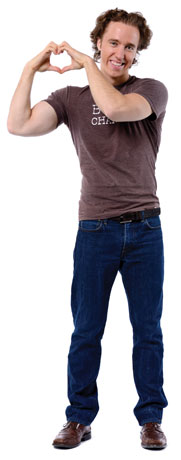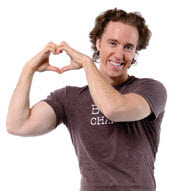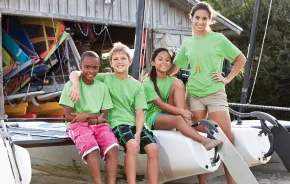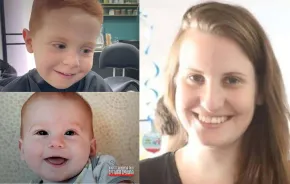At 12 years old, Toronto-born Craig Kielburger was featured on 60 Minutes for taking action against child slavery. He had read a  newspaper article about Iqbal Masih, a boy his own age in Pakistan. Iqbal’s parents, like many others, had offered their 4-year-old son’s labor in exchange for a small loan. Iqbal spent the next six years chained to a rug loom, working 12-hour days for pennies until he finally escaped and joined a crusade against child labor. Iqbal won worldwide recognition and then, at age 12, was shot dead in the streets of his village.
newspaper article about Iqbal Masih, a boy his own age in Pakistan. Iqbal’s parents, like many others, had offered their 4-year-old son’s labor in exchange for a small loan. Iqbal spent the next six years chained to a rug loom, working 12-hour days for pennies until he finally escaped and joined a crusade against child labor. Iqbal won worldwide recognition and then, at age 12, was shot dead in the streets of his village.
Today, 17 years later, Kielburger brings We Day to Seattle for its U.S. launch at Seattle’s KeyArena on March 27, for which 15,000 students will earn their ticket through their leadership roles in local and global actions. We Day, which is tied to the We Act program, is an initiative of Free The Children and brings youth together to lead global change.
How did your upbringing in Canada position you to read the article about Iqbal, act upon it, and set Free The Children and We Day/We Act into motion?
My parents were both teachers for more than 35 years. My mother was a special needs teacher, and my father taught high school French. They were not activists, but they raised us to be aware of the world around us. My mom never walked past a homeless person without giving something. She pulled us into her conversations, and in 30 seconds, she would ask the person where they were from, how long they had been on the streets and acknowledge their humanity. Mom’s conversations and interactions were more important to her than the money she gave.
Those interactions were amazing and consistent acts of humanity, and it must have been impactful to witness them as a child.
I really thought everyone did this. Not until my brother and I wrote a parenting book, as nonparents, called The World Needs Your Kid: Raising Children Who Care and Contribute, did we fully appreciate the endless teachable moments our parents provided. The book’s focus is on three C’s: compassion, courage and community. We wanted to impact schools beyond the R’s to the three C’s.
Well before “collective action” was the vogue label for good work among friends, you started Twelve-Twelve-Year-Olds when, of course, you were 12. What did you and 11 classmates hope to impact as sixth-graders?
It’s a little embarrassing because we thought this was the greatest name ever, until weeks later, someone had his 13th birthday. I had studied the Underground Railroad in Canada and how Lincoln had freed the slaves. I was shocked that slavery still existed. I brought the article [about Iqbal] to my class and got permission to talk about it.
This is a great example of the impact teachers can have well beyond their individual students. Mine said “Yes,” and it’s why we’re passionate about working with schools. I got friends to work together calling charities, and we kept getting the same message: Go find our parents’ credit cards, because that was how we should help. Instead, we just started having car washes and garage sales.
How long did this group stick together?
Not that long. We all went to different high schools. From our high school group we have our director of digital media, one woman runs our office in Haiti and is married a Haitian, and one is at the US State Department.
Tell us about the March 27 U.S. kickoff of We Day in Seattle.
For two years we searched for the right city to launch We Day. Many cities have invited us, but Seattle was selected for its innovation with education, policy, early learning, compassion action and philanthropy. Microsoft’s sponsorship has been integral to our Seattle launch as one of our key Washington partners.
You and your older brother, Marc, are numbers guys. Share some outcome measures of past We Day events and Free The Children success.
We have strong stats coming out of years in Canada, with 1.7 million students touching our programs in North America, 100,000 students attending We Day events from 3,000 schools, 5,700 schools watching live webcasts, and 2.4 million following on Facebook. Internationally, there have been 650 schools built, clean water and medical care have been provided for 1 million people, and 30,000 small businesses, mostly run by women, have launched.
We now measure gender parity, graduation rates and advancement to secondary school rates, test scores, infant mortality and infant birth rates. The whole model is that we want to leave these communities, but you have to have very easy and clear measures to check. This has been a massive shift from where we were 17 years ago, kicking down doors in Southeast Asia and rescuing kids, and then returning them to their homes.
It must have been painful and emotional to have joined the police in Southeast Asia as you did on the raids to free children.
I first went when I was 12 years old. It all happens really fast. Police grab children and their perpetrators. The truly emotional part was returning kids back to their families and seeing them reunite with their parents and the parents’ sheer disbelief that their kids are back home after years of being in slavery. Originally, our international side of Free The Children was basically kicking down doors and getting the kids out. But it was not working; 12–18 months later, the kids were back in the same horrific situations.
What changes did you make to deliver the results that you were hoping for?
We had to change the model and ask how we could create sustainable solutions so that these kids who were in brothels and being trafficked would never end up in these situations again. All of our learning came from initial failures and having to innovate. We saw clearly that there is no single solution or magic bullet to end poverty. We asked ourselves, 'how do we bring clean water, build schools, create medical clinics, and bring in food security?' If you build a medical clinic but don’t have clean water, you’re just treating an illness without preventing it.
The failure rate on water projects is stunningly high because you have to fund repairs. These small businesses are created but you need women to run them and therefor gender empowerment and education. I have never understood the single-solution concept because there is no single magic bullet to end poverty.
You talk about bringing five pillars together to make sustainable change in these villages to end poverty.
Yes, the adoptive village model comes from working to ensure clean water, food security, health care, education and small businesses exist. It’s the model we bring to a school to create a five-year plan of engagement into communities. Kids do fundraise, but they learn about the communities and create a very real link.
Our favorite is when a school signs on for five years. On the global side, you see these unique friendships formed and sustained between the village kids and volunteers from schools. Our success is evaluated not on money raised, but on global citizenship. Four years later, the graduating class gets to travel and cut the ribbon on the project completion. The bond created over five years is extraordinary.
Tell us about the social-enterprise division of Free The Children called Me to We.
We have a half-dozen social enterprises called Me to We that support Free The Children, and one is called Me to We Trips. These are trips for youth, families or companies; they go overseas and experience and work in Free The Children communities. The three-week programs offer youth a rustic experience halfway around the world, a chance for cultural immersion and an opportunity to serve the community.
For adults, we have rustic luxury — meaning a hot shower and flushing toilet. People come with their families, give of their time, sit with the community elders and help teach or build. They become ambassadors when they return home, carrying the Free The Children message. Our goal is to scale We Day/We Act across the U.S., and it requires a great first success in Seattle.
The “ah-ha” moment: My brother and I were in Sierra Leone, where we have a lot of projects. We were having a conversation on the decks, waiting for a shipment. This guy was shipping out, because there was no more funding, media interest, grants or donor dollars. His joke was: "When is the last time there was a George Clooney telethon here?"
We’re five years in a village before you can reach self-sufficiency. You need a stable source of income for that. So we got so desperate that we decided to go outside the traditional nonprofit models and set up social enterprises. They function as companies, but no dividend is paid out. Fifty percent of the profits goes to Free the Children, 50% gets reinvested to create the next social enterprise. Each enterprise has a structure, reporting requirements and an oversight board. We introduced styles of T-shirts, a trips division giving opportunities to youth, families and adults to go overseas and experience Free the Children communities, rustic experiences with showers and flush toilets.
Schools are so burdened. How do teachers and administrators get on board to participate in We Day/We Act, when they’re already so maxed out?
We know teachers are the unsung heroes and that they are overwhelmed. We create systems that make it easy to deliver service learning. We show better outcomes for students with this model, and it's plug-and-play with a menu of options, from speakers coming to the school to a workshop with tangible action plan tailored for the school. Weekly resources come to the teacher’s in-box to help support their actions. We Day is an incentive to earn your way in with one local and global service act, and teachers and students can pick what is best for them.
What does success look like at the end of the first U.S. We Day on March 27, 2013 in Seattle?
We walk away saying, “Wow, this is just the beginning.” We have a commitment to Seattle for the long term. We have never left a city that we brought We Day to. Short-term goals measure volunteerism; it’s how kids get tickets to We Day. Success is 20 years from now. We have a generation of active local and global citizens who carry the message that they can change the world, and they live this every day.
How did Seattle become the first U.S. city for We Day?
For six years, we were looking for a key strategic region. Many schools in Seattle already are involved, coming to We Day in Vancouver [British Columbia]. This region has great influence on policy in education. We Day/We Act have great local champions, such as coach Pete Carroll of the Seattle Seahawks. He is extremely persuasive and a great advocate for keeping kids out of gangs. As he says, “It’s not enough to give kids something to stay away from; we have to give them something positive to go toward.”
How can people and schools get involved now?
For more information on how you can get involved with We Day/We Act and Free The Children, please visit WeDay.com.



 At 12 years old, Toronto-born Craig Kielburger was featured on 60 Minutes for taking action against child slavery. He had read a
At 12 years old, Toronto-born Craig Kielburger was featured on 60 Minutes for taking action against child slavery. He had read a 





